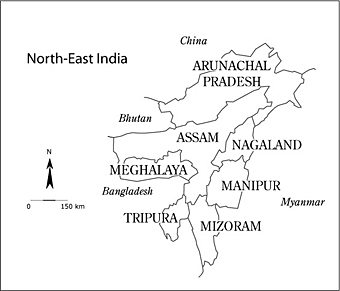North-East India

North-East India, or Greater Assam, including the seven Indian states of Assam, Arunachal Pradesh, Nagaland, Manipur, Mizoram, Tripura, and Meghalaya, was essentially closed to foreign researchers for nearly forty years. Parts of the region, excluding the areas bordering China and Burma, have been accessible for the last ten years. Ethnic identities remain strong; the processes of homogenization and folklorisation are not far advanced.
The region has the most rainfall of any in Asia. Rich variety is the rule in the native fauna and flora; in human economy (hunting, slash-and-burn agriculture, irrigated rice culture, tea-plantations, oil wells); in religion (Vishnuism, Sakti worship, Buddhism, Islam, Christianity), in social organisation, and in language. Integration into the Indian Union has not completely erased the traces of earlier political systems: Hindu states, Tai and Khasi principalities, autonomous chiefdoms.
In principle, the territory can be divided into two parts: irrigated lowlands, which are relatively accessible (in spite of floods, dense vegetation, dangerous wild animals, and endemic and epidemic diseases) and highlands where swidden agriculture (jhum) is practiced according to a variety of modes. These patterns, which are fundamental to the economy and the history of the landscape, will be systematically studied at a number of sites already identified in the field by the geographer Joëlle Smadja.
The opposition between highland and lowland must not be allowed to obscure the unique characteristics of the foothill regions, which have been under study by Philippe Ramirez. The groups which inhabit these regions may seem to have a double identity, highlander and lowlander, in the eyes of outsiders, but they see themselves as unified groups. The Arleng/Karbi and the Tiwa/Lalung are good examples. The paired names of these populations reflect two facets of a single “identity.”
The archaeological records provide some indications for the region over two millenia; the historical record, often quite detailed, covers some 800 years. Both can be exploited to advantage. Linguistic comparison reveals a kind of stratification of ethnic-linguistic layers (See the Linguistic Sketch Map on the next web page). The earliest — as indicated on the chart below — is the Mon-Khmer, represented by the Khasi languages of Meghalaya; this has apparently been followed by a series of Tibeto-Burman groups, then by Indo-Aryan, represented by Assamese and Bengali, and finally, at different periods since the 12th Century, Taï languages which never really took hold but which served as the vehicle for chronicles (a rare genre elsewhere in the Indian context) and important historical documents, and incidentally gave the region its name, “Assam,” related to “Siam” and “Shan,” locally pronounced “Ahom.”
Taï : Ahom and some recent imports
Indo-Aryen : Assamese
Tibeto-Burman : numerous “tribal” languages
Mon-Khmer : Khasi
This stratification, like the geographical one, is only an approximation; the Aryanisation of the valley has been the result of two familiar processes, immigration (here from Indian territories to the west and south), and acculturation of local populations. Behind the metaphor of layers are movement and mixture. But as a first approach we can take up each of these four categories in turn. Our sources on the history of Assam are Gait 1926, Baruah 1985 and 1993, and Jacquesson 1999.
The Taï speaking groups (Morey 2005) are certainly among the most recent arrivals. The earliest of them, the Ahom, were the authors of important chronicles (Gogoi 1986). They came from upper Burma — a fact which points to one of the traditional routes of access to Assam. They dominated and unified the region between the 16th and 19th centuries, but their language, Ahom, died out in the 17th century. There remain hundreds of manuscripts, for the most part unpublished.
Indo-Aryan languages (Masica 1991), today represented by a variety of Assamese and Bengali dialects, as well as more recently imported Nepali, Oriya, etc., probably only reached Assam early in the Christian era. There are archaeological sites, not completely inventoried, and Sanskrit documents (Sharma 1978) beginning in the 5th century. It is likely that early immigrants came in search of cultivable lands, with some Brahmans invited by local elites interested in Hindu culture and religion. Immigration has been a constant factor up to the present (today it comes mainly from Bangladesh).
The history of the groups who presently speak the more than 80 Tibeto-Burman languages of the region remains poorly understood. There has been recent work (Burling, Coupe, Jacquesson, Joseph, Jackson Sun) but much remains to be done, and there is no overall synthesis except at the level of the relatively accessible Boro-Garo subgroup in the Assam valley (perhaps Boro-Garo-Jinghpaw (Burling), extending to Burma and China) and the Tani subgroup in central Arunachal.
The last group is in fact presumably the first, the Khasi-Jaintia. They speak languages of the Mon-Khmer family, whose current center of gravity is in Southeast Asia, but which is also related to the very old Munda group of eastern peninsular India. It is supposed that Mon-Khmer languages once stretched from Southeast Asia at least to Assam, an area later split by Tibeto-Burman, Indo-Aryan and Tai incursions.
The ethnic diversity is not only linguistic, but also social and economic. Social and economic diversity are often not distributed along linguistic lines. The Tibeto-Burman-speaking Garo, for example, share matrilineal inheritance and uxorilocal marriage with the Mon-Khmer speaking Khasi (Nakane 1967), leaving open the question of the direction of influence (linguistic or social conversion). North-East India is an excellent field for the study of such fundamental processes in the interaction of human groups.
